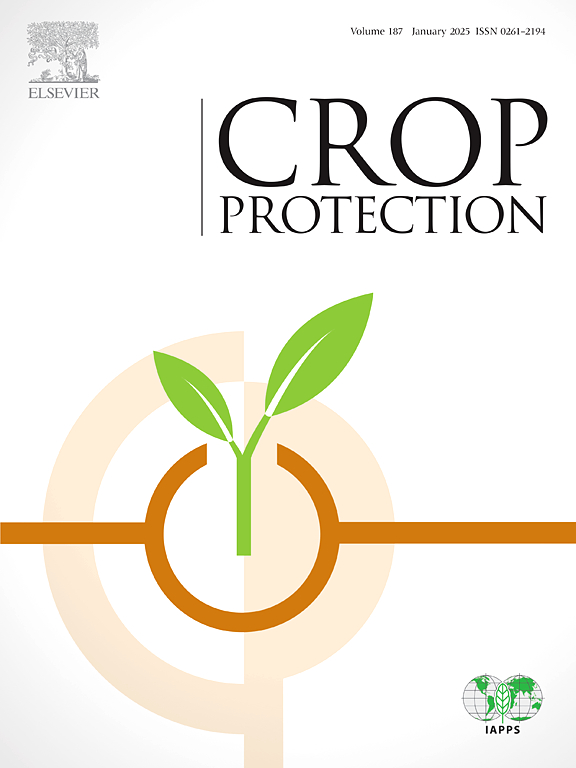中国花椒(Zanthoxylum bungeanum Maxim.)叶斑病新病原拟盘多毛孢
IF 2.5
2区 农林科学
Q1 AGRONOMY
引用次数: 0
摘要
花椒(Zanthoxylum bungeanum Maxim.)具有重要的经济和生态价值,广泛种植于热带和亚热带地区。但随着种植面积的增加,病害日益频繁和严重,严重威胁着产量和品质。叶斑病是影响这种作物的一种常见病害。2022年10月,中国贵州省贞丰县多处人工林发现花椒叶斑病,症状为近圆形或长方形棕红色病变,边缘呈黑色,发病率为17%。面对这一问题,本研究的目的是确定与这一症状相关的因果因素。病原鉴定为拟盘多毛孢(Pestalotiopsis trachycarpicola);通过形态特征、内部转录间隔区(ITS)、β-微管蛋白(tub2)和翻译伸长因子1-α (tef1-α)基因序列的分子系统分析,并进行致病性检测。据我们所知,这是国内首次报道的引起花椒叶斑病的P. trachycarpicola。本研究为制定花椒病害的防治策略提供了有价值的信息。本文章由计算机程序翻译,如有差异,请以英文原文为准。
Pestalotiopsis trachycarpicola, a new pathogen of Chinese prickly ash (Zanthoxylum bungeanum Maxim.) leaf spot disease in China
Chinese prickly ash (Zanthoxylum bungeanum Maxim.) is widely cultivated in tropical and subtropical regions for its significant economic and ecological values. However, with increasing acreage, diseases of this crop are becoming more frequent and severe, threatening yield and quality. Leaf spot is a common disease affecting this crop. In October 2022, leaf spots of Chinese prickly ash plants were found in many plantations in Zhenfeng County, Guizhou Province, China, with symptoms of suborbicular or oblong brownish-red lesions and black edges, occurring at an incidence of 17%. In the face of this problem, the aim of this study was to identify the causal agent associated with this symptom. The causal agent was identified as Pestalotiopsis trachycarpicola Y.M. Zhang & K.D. Hyde by morphological characteristics, molecular systematics of the internal transcribed spacer region (ITS), β-tubulin (tub2 ), and translation elongation factor 1-alpha (tef1-α ) genes sequences, and pathogenicity test. As far as we know, this is the first report of P . trachycarpicola causing leaf spot disease on Chinese prickly ash in China. This study provides valuable information for developing management strategies to control this disease on Chinese prickly ash.
求助全文
通过发布文献求助,成功后即可免费获取论文全文。
去求助
来源期刊

Crop Protection
农林科学-农艺学
CiteScore
6.10
自引率
3.60%
发文量
200
审稿时长
29 days
期刊介绍:
The Editors of Crop Protection especially welcome papers describing an interdisciplinary approach showing how different control strategies can be integrated into practical pest management programs, covering high and low input agricultural systems worldwide. Crop Protection particularly emphasizes the practical aspects of control in the field and for protected crops, and includes work which may lead in the near future to more effective control. The journal does not duplicate the many existing excellent biological science journals, which deal mainly with the more fundamental aspects of plant pathology, applied zoology and weed science. Crop Protection covers all practical aspects of pest, disease and weed control, including the following topics:
-Abiotic damage-
Agronomic control methods-
Assessment of pest and disease damage-
Molecular methods for the detection and assessment of pests and diseases-
Biological control-
Biorational pesticides-
Control of animal pests of world crops-
Control of diseases of crop plants caused by microorganisms-
Control of weeds and integrated management-
Economic considerations-
Effects of plant growth regulators-
Environmental benefits of reduced pesticide use-
Environmental effects of pesticides-
Epidemiology of pests and diseases in relation to control-
GM Crops, and genetic engineering applications-
Importance and control of postharvest crop losses-
Integrated control-
Interrelationships and compatibility among different control strategies-
Invasive species as they relate to implications for crop protection-
Pesticide application methods-
Pest management-
Phytobiomes for pest and disease control-
Resistance management-
Sampling and monitoring schemes for diseases, nematodes, pests and weeds.
 求助内容:
求助内容: 应助结果提醒方式:
应助结果提醒方式:


